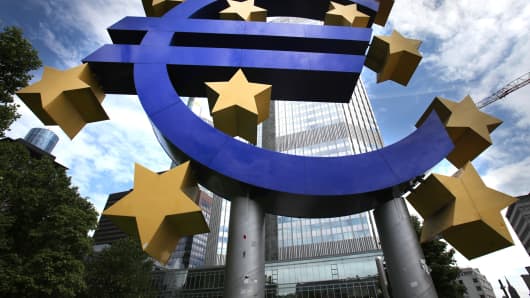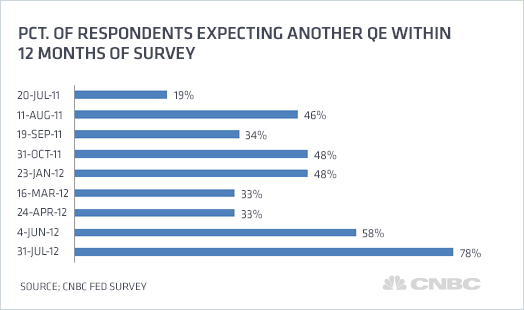The survey included responses from 50 economists, traders, analysts and money managers.
“The basic rationale for a third round of Quantitative Easing is that … the Fed needs to do more to do its part and end this period of sub-par nominal GDP (explain this) growth,” wrote Mike Dueker of Russell Investments in response to the survey. He’s looking for the Fed to act this week.
John Katter of Eastern Investment Advisors disagreed, saying, “Although I think more QE is coming, it will not be this year. The economy is not weak enough, the stock market is doing well, and interest rates are low enough.”
And former Fed President Lee Hoskins took the other extreme, noting continued sub-par growth following several Fed easing programs. “Doing QE3 and expecting a different outcome borders on the irrational,” he said.
Many market participants have pushed ahead their forecast for the first Fed tightening into 2015, with 48 percent now predicting no rate hike until then compared with 13 percent in the April survey.
The fed funds rate (explain this) is seen at just 0.3 percent all the way until the end of December, 2013. “The Fed now faces the possibility of trying to offset policy errors not only in the euro zone but also mistakes in its own backyard on Capitol Hill,” wrote Lynn Reaser, Point Loma Nazarene University.
The biggest threat facing the U.S. economy is the "fiscal cliff," chosen by 41 percent of respondents, taking the top spot away from the European financial crisis, which was picked by about a third.
The "fiscal cliff" refers to a combination of spending cuts and tax hikes that will go into effect at the end of the year unless Congress acts.
Seventy-eight percent say the fiscal cliff issue is already having a negative effect on business and the economy.
“The odds that we reach the 'cliff' with no action taken is rising,” said David Resler of Nomura Securities.
Added investment strategist Dennis Gartman: “The biggest test facing the U.S. economy is that we shall do something truly stupid: raise taxes and cut spending aggressively, doing immeasurable damage to the economy in the process.”
Recession (explain this) chances in next 12 months have jumped to 26 percent from 21 percent in June — the worst finding since September, 2011. Market participants for the first time are predicting sub-2 percent growth on average in 2012 compared with 2011 and see GDP growing just 2.26 percent next year, down from a 2.55 percent forecast in April.
As a result, market participants see stocks ending the year little changed from current levels, but rising 5 percent over the next 12 months. The 10-year Treasury yield (explain this) is forecast to rise to 1.7 percent by year-end and hover around 2 percent next June.
But QE is seen helping both rates and stocks. Asked the effects of a hypothetical $500 billion QE program, 90 percent said it would lead to higher equity prices. Twenty-eight percent said it would raise prices by 5 to 6 percent, the most popular choice.
Seventy percent said they believed QE would reduce mortgage rates, with about a third seeing an effect greater than 10 basis points. But just 42 percent said it would reduce yields on 10-year Treasurys and 23 percent predicted no change to yields.
A third believed QE could raise rates. A reduction in yields of 6 to 10 basis points was the most popular choice among those who predicted a decline in rates.
A full 82 percent of respondents now believe the euro zone will lose one or more countries in the next five years, either because they are ejected or leave, the highest percentage since CNBC began asking the question.
The default probability for Spain also hit a survey record of 38 percent and 80 percent continue to expect a second default from Greece. Meanwhile, concerns eased for defaults in Portugal and Ireland.




